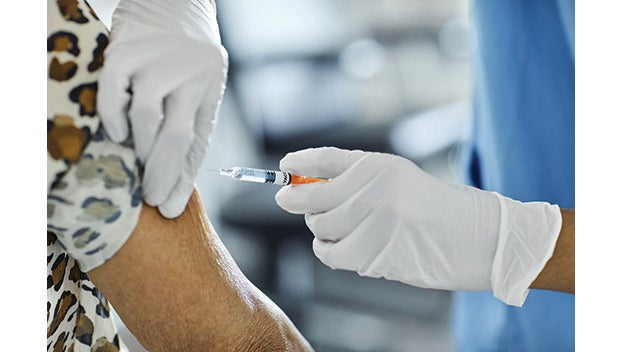Contact tracing phased out by VDH
Published 4:15 pm Friday, February 4, 2022
|
Getting your Trinity Audio player ready...
|
With COVID-19 case numbers finally dropping in the commonwealth, the Virginia Department of Health has announced it is transitioning away from universal case investigation and contact tracing in order to refocus investigation efforts to target congregate settings.
Most counties in the Piedmont Health District, with the exception of Lunenburg, saw drops in their case numbers this week.
According to the Virginia Department of Health (VDH) from the period of Monday, Jan. 24, to Monday, Jan. 31, Lunenburg saw a dramatic increase of 305 new virus cases.
Prince Edward saw 217 new COVID-19 cases over the last week. Buckingham reported 151 new virus cases, Cumberland saw 58 new cases, and Charlotte reported 122 new cases of COVID-19.
No local counties reported new COVID-related deaths in this period.
Longwood University was reporting 37 active cases of the virus in its most recent COVID dashboard update Sunday, Jan. 30. On Friday, Jan. 28, Hampden-Sydney was reporting 23 active cases of the virus with 19 individuals quarantining.
State data appeared encouraging this week in what many consider to be a signal that the omicron surge is indeed finally receding. On Monday, Jan. 31, VDH reported 4,247 new cases of the virus across Virginia, a significant decrease from the 7,155 cases reported the previous Monday.
The state’s seven-day moving average of cases saw a similar drop this week from 12,020 Jan. 24 to 9,194 on Jan. 31.
These welcome drops in COVID-19 cases are echoed in this week’s hospital data. On Jan. 31, Centra Health reported a total of 159 COVID patients in its Lynchburg, Bedford and Southside Hospitals, 17 of which were in the ICU and five of which were actively being vented. For several weeks, Centra has seen record numbers of hospitalizations for the coronavirus, including just last week when the hospital’s COVID census reached a new record of 192 patients.
Piedmont Health District Director Dr. Maria Almond pointed to the importance of this decline in a Jan. 31 statement.
“The Piedmont Health District continues to monitor hospitalization data closely, which seems to indicate locally the beginnings of a much-awaited decline from peak surge numbers,” Almond noted.
VDH announced a big change in its pandemic investigation efforts late last week following a Jan. 24 joint statement made by multiple health organizations in which officials announced they would be transitioning away from universal case investigation and contract tracing for individual cases of COVID-19.
The statement, issued together by the Council of State and Territorial Epidemiologist (CSTE) along with the Association of State and Territorial Health Officials (ASTHO), Association of Public Health Laboratories (APHL), National Association of County and City Health Officials (NACCHO) and Big Cities Health Coalition (BCHC) supports state, local, territorial and tribal (SLTT) health departments in transitioning away from universal case investigation and contact tracing at this point in the COVID-19 pandemic to a more strategic approach of outbreak investigations and targeted case investigations.
The following day, VDH announced it would indeed begin to refocus investigation efforts toward target congregate settings and phase out contact tracing efforts, particularly due to rapid spread of the omicron variant.
In VDH’s statement, officials noted while contact tracing played a critical role in protecting Virginians when vaccines were not available (including over 750,000 case investigations and 400,000 close contacts notified), with omicron now the most common variant across the U.S., it is not possible or fruitful to track every case.
“A change of tactics can be difficult, and it will feel uncomfortable, particularly for those of us who have been directly touched by the devastating losses incurred as a result of COVID,” Almond said in response to the change. “We are a traumatized nation. But we are in a different place than we were in March 2020. We have the miracle of vaccines; we have treatments to blunt the blow of severe disease; we have knowledge of how this disease spreads and awareness of the tools to best slow transmission. And for now, we have a variant that while highly transmissible and wily in its ability to escape some of our body’s defenses, is, by and large, milder, meaning it does not hospitalize those it inhabits as often.”
Almond said contact tracing was a tool VDH used to box in the virus, a strategy which is no longer feasible or working as intended.
“As a public health department, we are not stopping our work, but we are re-designing our strategy. We will continue our careful surveillance of outbreaks (defined as three or more cases in any particular setting), and we will focus most of our efforts in high-risk settings such as long-term care facilities. And, as always, we will continue to be a resource in providing knowledge and awareness of COVID-19 to the community.”
Almond said local schools will continue to work with the public health system around any outbreaks, and VDH has also asked all schools to continue to keep parents informed of cases within the schools, though parents may then need to decide for themselves what may be best for their child given a possible in-school exposure.
“As a parent, you may only know there are positive cases in a classroom or that a certain number of students within a grade level have reported confirmed COVID infections,” she said. “Given the difficulties in determining exact exposures in the school environment, it is likely that there may be broader strategies different from contact tracing that schools employ to reduce risk. For example, your child may instead be asked by class to universally mask for a short period of time if there is a known case in that classroom. Masks are not perfect, but they do provide a measure of protection and lessen the risk of both receiving or spreading many respiratory viruses. Schools will continue to provide maximal distancing possible and will strive to further improve ventilation. Any confirmed COVID-19 cases will isolate at home as required, and children exposed at home or in the community will still be asked to quarantine. VDH has provided increased resources to help with the decision-making from a parental perspective. And schools will continue to work with parents to decide what is best for any particular child and her/his risk factors.”
VDH’s full statement can be found at https://www.vdh.virginia.gov/ vdh-refocuses-covid-19-investigation-efforts-to-target-congregate-settings/.
On Monday, Almond spoke to the tension the pandemic has caused in the community and what this recent reduction in cases could mean for the future.
“We, as a community, have been in a place of extraordinary tension — attempting to balance the need to protect the hospital system from a significant influx of cases, while also needing to all be present and in service to each other in the community in order to keep us moving forward. We have all had to tread carefully and cautiously. But we have also had to continue to take important and necessary steps forward.
“We are not at a point of completely letting down our guard yet, but I hope that within the next 2-3 weeks, most of us will be able to begin to feel a sense of being able to move more freely again. And we will take with us renewed compassion for our immunocompromised neighbors or our seniors, for whom winter has always been a challenge of avoiding the threats of respiratory illnesses.”
Almond said even for those who have already been infected with COVID-19, it is still important to get the two-shot vaccine series.
“We now have evidence from several scientific studies that 3 mRNA vaccine doses provide up to 90% effective protection against hospitalization from the current Omicron variant,” she stated. “Getting vaccinated and boosted continues to work to keep you home and out of the hospital … Three looks at this virus gives your body enough information to keep most serious effects of COVID at bay.”
The Piedmont Health District continues to slowly increase its number of vaccinated and boosted individuals.
Vaccination rates in each county of the health district, as of Monday, were as follows:
Lunenburg: population fully vaccinated: 51.7%, population with booster shot: 20.8%
Prince Edward: population fully vaccinated: 44.2%, population with booster shot: 21%
Buckingham: population fully vaccinated: 51.9%, population with booster shot: 22.4%
Cumberland: population fully vaccinated: 47.8%, population with booster shot: 19.1%
Charlotte: population fully vaccinated: 51.6%, population with booster shot: 21.7%



